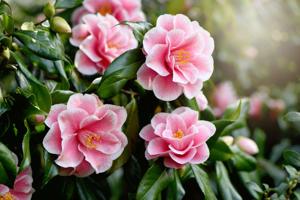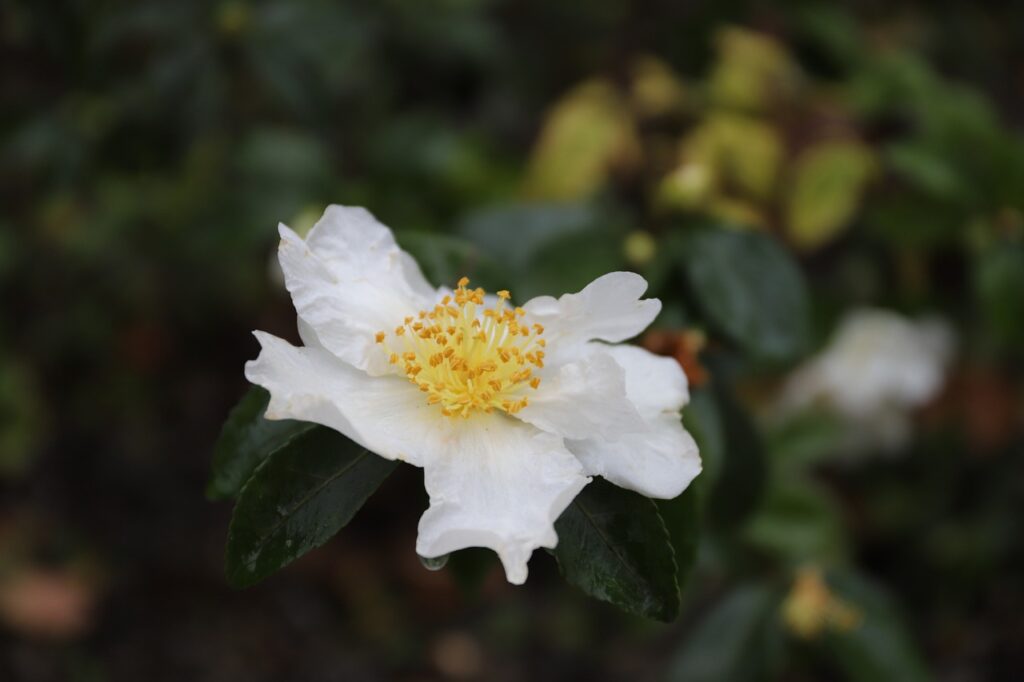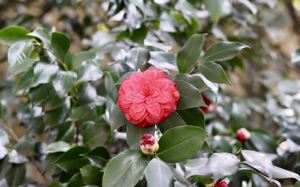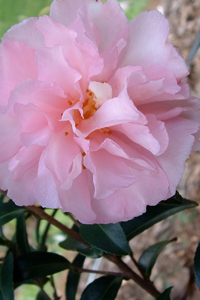Winter Care for Camellia Sasanqua: What You Need to Know

Introduction
The Camellia sasanqua is a shrub that brings life and color during the winter months. Called the “Winter Camellia” or “Christmas Camellia,” this plant has captivated gardeners.
Native to Japan and China, Camellia sasanqua has been cultivated for centuries. The Camellia japonica often steals the spotlight in spring gardens. The sasanqua offers advantages that make it valuable for winter interest.
Historical Significance
In Japanese culture, Camellia sasanqua holds a special place in traditional gardens. It’s known as “Sazanka.” Records show that Japanese gardeners have cultivated these plants since the 14th century. They were cultivated for:
- Oil production: The seeds were to create high-quality oil for cooking and hair care
- Tea ceremonies: The leaves were used as a tea substitute
- Religious significance: The plants were often found in temple gardens
- Medicinal purposes: Traditional healers used various parts of the plant in natural remedies
Key Differences from Camellia Japonica
The Camellia sasanqua differs from C. japonica in several important ways:
- Blooming Season:
- Sasanqua: October to December
- Japonica: January to March
- Flower Characteristics:
- Sasanqua: Smaller, more delicate blooms with a sweet fragrance
- Japonica: Larger, showier flowers without scent
- Growth Habit:
- Sasanqua: More versatile, often faster-growing with a more open, spreading habit
- Japonica: Generally more upright and formal in appearance
- Sun Tolerance:
- Sasanqua: More sun-tolerant, can handle partial to full sun
- Japonica: Prefers more shade, especially in hot climates
What Makes Camellia Sasanqua Special
The Camellia sasanqua stands out in the winter garden for compelling reasons:
- Winter Interest: Provides vibrant color during the coldest months
- Fragrance: Many varieties offer a subtle, sweet scent
- Versatility: Works well as hedges, specimens, or container plants
- Low Maintenance: Generally resistant to pests and diseases
- Long-Blooming: Individual plants can flower for 4-6 weeks
- Bird-Friendly: Attracts winter birds with dense foliage for shelter
Understanding Camellia Sasanqua Basics
Plant Profile
Camellia sasanqua belongs to the tea family (Theaceae). It shares lineage with ornamental and important plants. Here’s a detailed breakdown of its characteristics:
Scientific Classification:
- Kingdom: Plantae
- Family: Theaceae
- Genus: Camellia
- Species: C. sasanqua
Natural Habitat and Origin: Native to the southern Japanese islands. Camellia sasanqua grows in:
- Mountainous regions between 300-1,000 meters elevation
- Areas with acidic, well-draining soil
- Regions with moderate rainfall and humidity
- Forest understory environments
Growth Characteristics:
- Height: Reaches 6-10 feet tall
- Spread: Can grow 4-8 feet wide
- Growth Rate: Moderate, averaging 6-12 inches per year
- Lifespan: Can live 50-100 years with proper care
- Maturity: Reaches full maturity in 10-15 years
Distinctive Features
Leaf Characteristics
Camellia sasanqua leaves are different from other camellia species:
- Size: 1.5-3 inches long
- Shape: Elliptical to ovate
- Texture: Glossy and leathery
- Color: Dark green with serrated edges
- Arrangement: Alternate placement on stems
Flower Types and Colors
The blooms of Camellia sasanqua come in several forms:
- Single: 5-8 petals with visible stamens
- Semi-double: 2-3 rows of petals
- Double: Many layers of petals
- Formal double: Organized, symmetrical petal arrangement
Color Range:
- Pure white
- Soft pink
- Deep rose
- Bright red
- Bicolor varieties
Blooming Period
Camellia sasanqua’s flowering schedule follows a predictable pattern:
- Peak Bloom: October through December
- Duration: Individual flowers last 3-4 days
- Plant Bloom Time: 4-6 weeks total
- Regional Variations: Earlier in warmer zones, later in cooler areas
Growth Habit
The growth pattern of Camellia sasanqua makes it versatile in the landscape:
- Form:
- Upright-spreading
- Dense branching structure
- Responds well to pruning
- Can be trained as espalier
- Seasonal Behavior:
- Spring: Active new growth
- Summer: Leaf and bud development
- Fall: Flower bud formation
- Winter: Blooming period
Environmental Adaptability
Camellia sasanqua shows adaptability to various conditions:
- Temperature Range: -5°F to 100°F (-20°C to 38°C)
- Soil Tolerance: Adapts to various soil types if well-draining
- Light Flexibility: More sun-tolerant than other camellias
- Urban Tolerance: Handles pollution well
- Salt Tolerance: Moderate resistance to salt spray

Growing Camellia Sasanqua
Ideal Growing Conditions
The environment for your Camellia sasanqua is important for optimal growth and flowering.
USDA Hardiness Zones
- Primary Growing Range: Zones 7-10
- Marginal Areas: Zone 6 with protection
- Best Performance: Zones 8-9
- Temperature Requirements:
- Ideal day temperature: 60-75°F (15-24°C)
- Minimum winter temperature: 10°F (-12°C)
- Maximum summer temperature: 95°F (35°C)
Light Preferences
Optimal Conditions:
- Morning sun with afternoon shade
- Dappled sunlight throughout the day
- Eastern exposure
- Northern exposure in hot climates
Light Intensity Guidelines:
- Full Sun: Acceptable in cooler climates
- Partial Shade: Ideal in most regions
- Full Shade: May reduce flowering
- Winter Sun: Beneficial for bloom production
Soil Requirements
The success of your Camellia sasanqua depends on proper soil:
Soil Type:
- Well-draining, organic-rich soil
- Sandy loam to clay loam
- High organic matter content (30-40%)
- Good moisture retention while avoiding waterlogging
Soil pH Requirements:
- Optimal range: 5.5-6.5
- Acceptable range: 5.0-7.0
- Testing recommendation: Annually
- pH change methods:
- Lower pH: Add sulfur or aluminum sulfate
- Raise pH: Add dolomitic lime
Planting Guide
Best Time to Plant
Timing your Camellia sasanqua planting is important for establishment:
Preferred Planting Seasons:
- Fall: Optimal (September-November)
- Spring: Secondary option (March-April)
- Summer: Avoid unless necessary
- Winter: Not recommended in freeze-prone areas
Site Selection
Essential Criteria:
- Protection from:
- Strong winds
- Afternoon sun in hot climates
- Winter frost pockets
- Proximity to:
- Buildings (3-6 feet away)
- Other shrubs (4-8 feet)
- Trees (outside drip line)
Spacing Requirements
Proper spacing ensures healthy growth and good air circulation:
Recommended Spacing:
- Hedges: 3-4 feet apart
- Specimen plants: 6-8 feet apart
- Mass plantings: 4-5 feet apart
- Container growing: One plant per 15-20 gallon container
Planting Depth and Technique
Step-by-Step Planting Process:
- Hole Preparation:
- Width: 2-3 times root ball diameter
- Depth: Equal to root ball height
- Bottom: Firm, not compacted
- Soil Preparation:
- Mix native soil with organic matter (50/50)
- Add acidifying amendments if needed
- Incorporate slow-release fertilizer
- Plant Positioning:
- Set higher than the surrounding soil
- Root crown 1-2 inches above grade
- Check for straight alignment
- Backfilling:
- Use prepared soil mixture
- Firm to remove air pockets
- Create shallow water basin
- Post-Planting Care:
- Water thoroughly
- Apply 2-3 inches of mulch
- Keep mulch away from trunk
- Stake if necessary in windy sites
Essential Care Instructions
Watering Requirements
Proper watering is important for Camellia sasanqua’s health and flowering performance. Understanding the plant’s moisture needs ensures optimal growth.
Watering Frequency Guidelines
Seasonal Watering Schedule:
- Spring (Growing Season):
- 1-2 times per week
- 1-1.5 inches of water per session
- Morning watering preferred
- Summer (Maintenance):
- 2-3 times per week during hot periods
- Deep watering encouraged
- Check soil moisture daily
- Fall (Pre-blooming):
- Reduce to once weekly
- Maintain consistent moisture
- Avoid overhead watering
- Winter (Blooming):
- Water when the soil feels dry
- Protect from freezing
- Reduce frequency in rainy periods
Signs of Improper Watering
Overwatering Symptoms:
- Yellow leaves
- Leaf drop
- Root rot
- Fungal growth
- Wilting despite wet soil
Underwatering Indicators:
- Crispy leaf edges
- Bud drop
- Stunted growth
- Leaf curl
- Slow recovery when watered
Moisture Retention Techniques
- Mulching Strategies:
- Apply 2-3 inches of organic mulch
- Keep mulch away from trunk
- Refresh mulch annually
- Use pine needles or bark
- Soil Amendments:
- Add organic matter
- Incorporate water-holding crystals
- Use composted materials
- Consider biochar

Fertilization Guidelines
Proper nutrition is essential for the growth and blooming of Camellia sasanqua.
Fertilizer Selection
Recommended Types:
- Slow-release: 12-4-8 or 10-5-5
- Organic options:
- Cottonseed meal
- Fish emulsion
- Composted manure
- Acid-forming fertilizers:
- Holly-tone
- Camellia-specific formulations
Application Schedule
Annual Fertilization Timeline:
- Early Spring (February-March):
- First application
- Light feeding
- Use slow-release formula
- Late Spring (May):
- Second application
- Full-strength feeding
- Include micronutrients
- Mid-Summer (July):
- Final application
- Reduce quantity
- Focus on phosphorus and potassium
Signs of Nutrient Deficiency
Common Deficiencies and Symptoms:
- Nitrogen:
- Yellowing older leaves
- Reduced growth
- Pale foliage
- Iron:
- Yellow leaves with green veins
- New growth affected first
- Stunted development
- Magnesium:
- Leaf margin yellowing
- Older leaf chlorosis
- Poor flower development
Pruning and Maintenance
Proper pruning maintains shape, promotes growth, and ensures blooming.
Pruning Timeline
Annual Pruning Schedule:
- Early Spring (March):
- Major structural pruning
- Remove dead wood
- Shape change
- Late Spring (May):
- Light trimming
- Pinch new growth
- Remove crossing branches
- Summer (June-August):
- Maintenance pruning
- Remove water sprouts
- Shape maintenance
- Fall/Winter:
- Minimal pruning
- Remove damaged growth
- Deadhead spent blooms
Maintenance Tasks
Regular Care Checklist:
- Weekly Tasks:
- Remove dead flowers
- Check for pests
- Check soil moisture
- Monthly Tasks:
- Inspect for disease
- Clean up fallen debris
- Check mulch level
- Seasonal Tasks:
- Adjust fertilizer program
- Update watering schedule
- Assess pruning needs
- Annual Tasks:
- Major pruning
- Soil testing
- Mulch replacement
Popular Camellia Sasanqua Varieties
Traditional Cultivars
‘Mine-No-Yuki’ (White Doves)
Characteristics:
- Pure white, double flowers
- Spreading growth habit
- Height: 4-6 feet
- Width: 6-8 feet
- Blooming period: October-December
‘Setsugekka’
Characteristics:
- Semi-double white flowers
- Upright growth
- Height: 8-10 feet
- Width: 4-6 feet
- Blooming period: September-November
‘Yuletide’
Characteristics:
- Single red flowers
- Compact growth
- Height: 4-5 feet
- Width: 3-4 feet
- Blooming period: November-January
‘Sunshine Girl’
- Peach-colored blooms
- Upright columnar growth
- Height: 8-10 feet
- Long blooming season
- Sun tolerant
Specialty Varieties
Container Specialists
- ‘Little Liane’
- Dwarf habit
- Prolific bloomer
- Perfect for pots
- Easy care
- ‘Petite Pink’
- Compact form
- Continuous blooming
- Small leaves
- Shallow roots
Hedge Forms
- ‘Green Screen’
- Dense growth
- Quick establishment
- Good privacy
- Easy shearing
- ‘Hedge Master’
- Upright habit
- Fast growing
- Disease resistant
- Drought tolerant

Common Problems and Solutions
Pest Management
Common Insect Pests
Tea Scale
- Identification:
- White or brown coating on leaf undersides
- Yellowing leaves
- Stunted growth
- Treatment:
- Horticultural oil sprays
- Systemic insecticides
- Regular monitoring
- Preventive spraying
Spider Mites
- Signs:
- Fine webbing
- Stippled leaves
- Bronzing foliage
- Control Methods:
- Increase humidity
- Insecticidal soap
- Predatory mites
- Regular leaf washing
Aphids
- Symptoms:
- Curled new growth
- Sticky honeydew
- Black sooty mold
- Solutions:
- Strong water spray
- Neem oil
- Ladybugs release
- Pruning affected areas
Prevention Methods
- Cultural Controls:
- Maintain plant vigor
- Proper spacing
- Good air circulation
- Regular inspection
- Natural Deterrents:
- Companion planting
- Beneficial insects
- Organic sprays
- Physical barriers
Disease Control
Common Diseases
Root Rot
- Causes:
- Poor drainage
- Overwatering
- Compacted soil
- Treatment:
- Improve drainage
- Reduce watering
- Fungicide application
- Root pruning
Leaf Spot
- Identification:
- Brown or black spots
- Leaf yellowing
- Premature leaf drop
- Management:
- Remove affected leaves
- Improve air circulation
- Fungicide treatment
- Avoid overhead watering
Petal Blight
- Symptoms:
- Brown spots on flowers
- Rapid flower collapse
- Fuzzy growth on petals
- Control:
- Remove infected blooms
- Clean fallen flowers
- Preventive fungicides
- Mulch management
Early Warning Signs
Watch for:
- Leaf Changes:
- Discoloration
- Spotting
- Wilting
- Texture changes
- Growth Issues:
- Stunted shoots
- Dieback
- Leaf drop
- Poor flowering
- Root Problems:
- Slow growth
- Yellow leaves
- Wilting despite moisture
- Root discoloration
Prevention Strategies
Cultural Practices:
- Site Preparation:
- Good drainage
- Proper spacing
- Air circulation
- Soil testing
- Maintenance:
- Regular cleaning
- Proper pruning
- Balanced feeding
- Moisture management
- Monitoring:
- Weekly inspection
- Record keeping
- Photo documentation
- Seasonal assessment
Landscape Uses for Camellia Sasanqua
The versatility of Camellia sasanqua helps its potential in landscape applications.
Design Applications
Foundation Plantings
Benefits:
- Year-round structure
- Winter interest
- Architectural enhancement
- Scale appropriate
Implementation Tips:
- Spacing:
- 3-4 feet from foundation
- 4-6 feet between plants
- Allow for mature size
- Consider windows and doors
- Design Principles:
- Layer with other shrubs
- Create depth
- Frame entryways
- Complement architecture
Hedges and Screens
Formal Hedges:
- Plant 2-3 feet apart
- Regular shearing
- Maintain desired height
- Even growth pattern
Natural Screens:
- Plant 3-4 feet apart
- Allow natural form
- Minimal pruning
- Privacy focus
Container Gardening
Container Selection:
- Size Requirements:
- Minimum 15-gallon capacity
- 18-24 inches deep
- Good drainage holes
- Frost-resistant material
- Growing Medium:
- Well-draining soil mix
- Added organic matter
- pH-adjusted substrate
- Moisture retention
Container Care Tips:
- Regular watering
- Seasonal feeding
- Root pruning
- Winter protection
Focal Points
Specimen Planting:
- Location Selection:
- Visible from indoors
- Near gathering areas
- Along pathways
- Entry highlights
- Design Enhancement:
- Lighting placement
- Mulch selection
- Companion plants
- Hardscape elements
Cut Flowers
Harvesting Tips:
- Timing:
- Early morning
- Semi-open blooms
- Clean cuts
- Sharp tools
- Conditioning:
- Warm water
- Remove lower leaves
- Cut stems underwater
- Use floral preservative
Traditional Uses
Tea Production:
- Leaf harvesting
- Processing methods
- Storage requirements
- Brewing techniques
Medicinal Applications:
- Historical uses
- Oil extraction
- Traditional remedies
- Modern applications
Modern Landscape Applications
Sustainable Gardens
Environmental Benefits:
- Wildlife Support:
- Bird habitat
- Pollinator attraction
- Winter shelter
- Food source
- Resource Conservation:
- Drought tolerance
- Low maintenance
- Long lifespan
- Minimal chemicals
Urban Gardens
Space-Saving Solutions:
- Vertical Gardens:
- Espalier techniques
- Wall mounting
- Trellis training
- Living screens
- Small Space Design:
- Container groupings
- Mixed borders
- Courtyard features
- Patio accents

Seasonal Care Calendar
Spring Tasks (March-May)
Early Spring (March)
Primary Focus: Post-winter recovery and growth preparation
- Pruning:
- Remove winter damage
- Shape plants
- Thin out dense growth
- Clean up dead wood
- Soil Care:
- Test soil pH
- Add amendments
- Refresh mulch
- Clear winter debris
- Fertilization:
- First feeding (early March)
- Use balanced fertilizer
- Apply at half-strength
- Water thoroughly
Mid-Spring (April)
Focus: Active growth support
- Pest Management:
- Check for scale
- Check for aphids
- Preventive treatments
- Inspect new growth
- Watering:
- Resume regular schedule
- Track soil moisture
- Adjust for rainfall
- Deep watering
Late Spring (May)
Focus: Summer preparation
- Growth Management:
- Light pruning
- Pinch new shoots
- Remove crossed branches
- Shape maintenance
- Disease Prevention:
- Watch for leaf spot
- Check drainage
- Improve air circulation
- Apply preventive sprays
Summer Maintenance (June-August)
Early Summer Tasks
- Water Management:
- Increase frequency
- Morning watering
- Check moisture levels
- Adjust for heat
- Fertilization:
- Second feeding
- Focus on growth
- Balance nutrients
- Check response
Mid-Summer Care
- Heat Protection:
- Mulch check
- Shade assessment
- Wind protection
- Moisture retention
- Pest Control:
- Spider mite check
- Scale inspection
- Natural predators
- Treatment if needed
Fall Preparation (September-November)
Early Fall
- Bloom Preparation:
- Reduce fertilizer
- Clean plant base
- Check support stakes
- Remove weak growth
- Disease Prevention:
- Clear fallen leaves
- Improve ventilation
- Check drainage
- Preventive spraying
Mid-Fall
- Bud Development:
- Check bud set
- Protect from frost
- Light pruning only
- Remove competitors
- Site Preparation:
- Add winter mulch
- Check drainage
- Clear debris
- Prepare protection
Late Fall
- Bloom Management:
- Remove spent flowers
- Protect buds
- Clean fallen petals
- Check for petal blight
Winter Protection (December-February)
Early Winter
- Cold Protection:
- Install barriers
- Apply anti-transpirants
- Check mulch levels
- Watch forecasts
- Bloom Care:
- Deadhead regularly
- Clean fallen blooms
- Protect from wind
- Check humidity
Mid-Winter
- Maintenance:
- Light cleaning
- Snow removal
- Ice prevention
- Structure check
- Problem Prevention:
- Watch for damage
- Check moisture
- Check supports
- Clear debris
Late Winter
- Spring Preparation:
- Plan pruning
- Order supplies
- Check tools
- Review care plan
Year-Round Monitoring
Monthly Tasks
- General Inspection:
- Health
- Growth patterns
- Pest presence
- Disease signs
- Documentation:
- Blooming dates
- Growth rates
- Problem areas
- Success notes
Seasonal Transitions
- Preparation:
- Tool cleaning
- Supply inventory
- Schedule review
- Task planning
- Assessment:
- Performance review
- Adjustment needs
- Future planning
- Success evaluation
Propagation Methods
Growing from Seeds
Seed Collection and Preparation
- Harvesting:
- Collect mature pods (October-November)
- Look for splitting pods
- Choose healthy specimens
- Clean and sort seeds
- Preparation Steps:
- Remove outer coating
- Float test for viability
- Scarification if needed
- Storage considerations
Seed Planting Process
- Soil Mixture:
- Equal parts:
- Peat moss
- Perlite
- Vermiculite
- pH 5.5-6.5
- Equal parts:
- Planting Method:
- 1-inch depth
- Horizontal orientation
- Proper spacing
- Moisture control
- Growing Conditions:
- Temperature: 70-75°F
- Humidity: 60-70%
- Indirect light
- Consistent moisture
Stem Cuttings
Cutting Selection
Optimal Characteristics:
- Semi-hardwood stems
- 4-6 inches long
- Healthy growth
- No flower buds
Timing:
- Late summer preferred
- Early morning collection
- After a flush of growth
- Before dormancy
Preparation Process
- Cutting Treatment:
- Remove lower leaves
- Wound base
- Apply rooting hormone
- Sanitize tools
- Rooting Medium:
- Sharp sand
- Perlite mix
- Sterile medium
- Good drainage
Growing Environment
- Humidity Control:
- Misting system
- Plastic covering
- Regular monitoring
- Gradual hardening
- Temperature Requirements:
- Bottom heat: 70-75°F
- Air temperature: 65-70°F
- Night temperature: 60-65°F
- Consistent control
Air Layering
Preparation Steps
- Branch Selection:
- Healthy stems
- Pencil thickness
- Previous year’s growth
- Good access
- Technique:
- Ring bark removal
- Hormone application
- Moss placement
- Wrap securing
Maintenance
- During Rooting:
- Keep moss moist
- Monitor progress
- Check wrapping
- Watch for growth
- Separation:
- After root formation
- Clean cuts
- Proper timing
- Careful handling
Frequently Asked Questions
Common Concerns
Q: When is the best time to plant Camellia Sasanqua? A: Early fall is good for allowing roots to establish before winter. Spring planting is acceptable in colder regions.
Q: How long until my plant flowers? A: Expect blooms within 2-3 years of planting, though some varieties may flower sooner.
Growth Issues
Q: Why isn’t my plant growing? A: Check these key factors:
- Soil pH and drainage
- Light exposure
- Planting depth
- Fertilizer schedule
Q: How can I encourage bushier growth? A: Regular pinching of new growth and pruning after flowering promotes dense growth.
Flowering Problems
Q: Why aren’t my buds opening? A: Common causes include:
- Temperature fluctuations
- Drought stress
- Improper nutrition
- Late season fertilizing
Maintenance Questions
Q: How often should I fertilize? A: Apply acid-forming fertilizer:
- Early spring
- Late spring
- Mid-summer Avoid late-season feeding

Conclusion
Key Points Summary
- Success depends on proper site selection and soil preparation
- A regular maintenance schedule is crucial
- Regional adaptations make a significant difference
- Prevention is easier than treatment for most issues